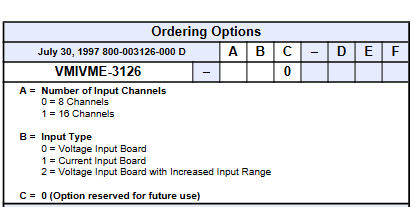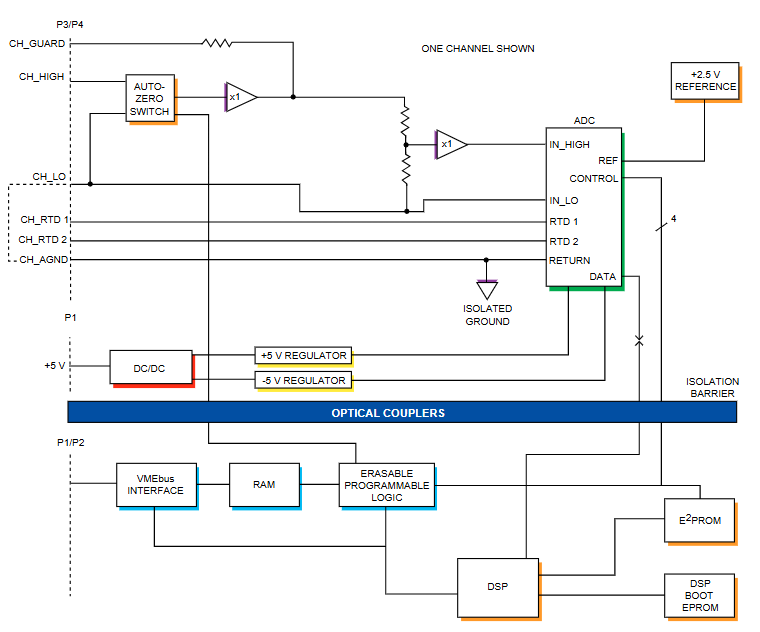GE VMIVME-3126 High Resolution Isolated Analog to Digital Converter Board
GE VMIVME-3126 High Resolution Isolated Analog to Digital Converter Board
Product Overview
VMIVME-3126 is an 8-channel or 16 channel high-resolution fully isolated analog-to-digital converter (ADC) board that can accept 2-wire isolated signals ranging from 50 mV to 10 V as input, providing isolation between channels and between channels and VMEbus. Each input is sampled and digitized by a dedicated 24 bit analog-to-digital converter, which automatically scans all inputs after on-board self-test is completed upon power on. Its accuracy is optimized through internal gain and offset correction, which are applied by a digital signal processor (DSP) in real-time mode and determined in calibration mode.

Core functions and parameters
Key Features
8 or 16 isolated input channels with source protection, 16 bit data.
The isolation voltage between channels and between channels and VMEbus is 1500 VDC (1000 VAC).
Each channel is equipped with a dedicated digitizer with an input range of ± 50 mV to ± 10 V, which can be selected by software according to the channel.
Software controlled bandwidth, 0.05 to 26 Hz (implemented through an internal DSP with a 6th order low-pass filter).
Real time offset and gain correction based on DSP, with E ² PROM storage of calibration coefficients supported by DSP (without fine adjustment potentiometer).
The conversion rate per channel is 100 SPS (samples per second).
Software controlled RTD excitation (200 mA/400 mA per channel), software controlled open circuit sensor detection.
Supported by VMIC's I/O controller, optional current termination resistors and optional increase in input range are available.
Application field
Including power plant monitoring, machine monitoring, data acquisition, as well as applications related to RTDs, strain gauges, and thermocouples.
Features
VMEbus access and compatibility: The response to address modifiers can be selected through jumpers, including A24 or A16 address space, monitoring or user permissions (or both), D16/D8 (EO) DTB slave, with a 6U external specification.
Board address: The VMEbus base address is configured by jumper fields, and each address A23 to A8 has a jumper, so the address space occupied by the board is 256 bytes.
Operation Mode
Sampling mode: After successful onboard self-test, all inputs are sampled simultaneously when powered on.
Calibration mode: Enter calibration mode by setting the bits in the board and status register (BSR). Each channel is calibrated by the DSP using up to seven external calibration voltage inputs. The gain and offset coefficients are stored in the DSP for real-time calibration. Users can set another bit in the BSR to write the coefficients to the E ² PROM or input their own gain and offset coefficients.
Configuration mode: Enter configuration mode by setting the bit in BSR, and each channel can be individually configured with range, filter frequency, data output format, and input type (normal, RTD excitation, open circuit sensor detection).
Automatic zeroing mode: Enter the automatic zeroing mode by setting the bit in BSR. In this mode, each input is disconnected from the field through an electronic switch, connected to a ground reference, digitized, and compared with the ideal ground reading. Adjust the offset coefficient to eliminate this difference. This technology can compensate for temperature changes without calibration operations.
Self check: After the system or software is reset, it automatically runs a self check to test the onboard RAM and each ADC. The status register indicates the success or failure status of these components.
Front panel indicator: The program controlled front panel LED lights up red during startup, calibration, and channel reconfiguration, and turns off after successfully completing the above modes.
Board Identification: The Board Identification Register (BIR) contains the VMIVME-3126 identification code.
Input characteristics
Number of input channels: 8 or 16 isolated 2-wire channels, each with an active protection pin.
Isolation voltage: 1500 VDC and 1000 VAC between channels and between channels and VME.

Input range (software control)
Bipolar: ± 50 mV, ± 100 mV, ± 500 mV, ± 1 V, ± 5 V, ± 10 V
Monopolar: 0 to 50 mV, 0 to 100 mV, 0 to 500 mV, 0 to 1 V, 0 to 5 V, 0 to 10 V
Input filter: 0.05 to 26 Hz low-pass, 6th order, filter cut-off frequency controlled by software, filtering executed by DSP software, approximate Bessel response.
Accuracy: The accuracy of the full-scale range varies in different ranges, such as ± 10 V, ± 5 V, 0-10 V, 0-5 V for 0.0030% full-scale, ± 1 V for 0.0076% full-scale, etc. (applicable after calibration of the selected input voltage range).
Stability: The temperature drift is ± V/° C, and the offset error caused by temperature can be eliminated by automatic zeroing.
Input noise: The typical and maximum noise varies under different filter settings and ranges, with noise units in μ V RMS.
Bandwidth of each input: DC to Fc, Fc is 0.05 to 26 Hz (default cutoff frequency is 26 Hz).
Input impedance: minimum, powered on (not applicable to boards equipped with current input options).
Channel crosstalk: The maximum is -150 dB at 1 kHz and Fc=1 Hz.
Isolation mode suppression: 160 dB at 60 Hz and Fc=1 Hz.
Overvoltage protection: ± 25 V wire to wire.
RTD excitation (software control per channel): typical 20 PPM/° C, maximum 20%.
Open circuit sensor detection (controlled by software for each channel): It functions normally in all ranges below ± 1 V (0-1 V).
Channel protection: Active output with unity gain and 1 k Ω source impedance.
Current terminal resistance: see the available options section.
Transmission characteristics
Transfer function: E IN=E LO+[E fsr × 65536N ADC], where E IN is the channel input voltage, E LO
For the lower limit of the input range, E fsr is the full-scale input range, and N ADC is the output code.
Resolution: 16 bits.
Input sampling: All inputs are sampled simultaneously.
Integral nonlinearity: maximum ± 0.005% compared to the optimal straight line.
Channel sampling rate: 100 SPS per channel, total 1600 SPS.
Data encoding: Software programmable, binary complement or straight/offset binary.
Data buffer memory
Buffer size: 16 consecutive 16 bit data words.
Access time: 400 ns from DS to DTACK.
VMEbus access: D8 or D16.

Available options (see ordering options)
Number of input channels: 8 or 16 2-wire channels.
Current terminal resistor: a resistor placed at both ends of the input, with a maximum continuous input current of 25 mA (calibrated input specified in current units rather than voltage units).
Increase input range: The input structure can handle an input range of up to ± 200 VDC.
Physical/Environmental Characteristics
Temperature range: working (standard VME slot) 0 to+65 ° C, storage -40 to+85 ° C.
Humidity: 10 to 80% relative humidity, no condensation.
Altitude: Working up to 10000 feet (3048 meters).
Cooling: forced air convection (standard VME slot).
Size: Dual height European card (6U) board, 160 x 233.35mm.
Weight: Maximum 700 g.
Input connectors: Two 64 pin DIN connectors.
Connector data
Recommended style for connecting components P3 and P4 I/O connectors
64 pin, compatible connector (96 pin discrete) AMP 925486-1*
Discrete line, female pressure contact point (64 pin discrete) AMP 530151-6**
(64 pin connector) connector housing Harting 09 02 064 0501
Note: * The middle row is not connected; **AMP crimping tool part number 90301-2.
Power requirements
+5 VDC (± 5%), maximum 2.8 A.
Mean Time Between Failures (MTBF)
97850 hours (217F).

- EMERSON
- Honeywell
- CTI
- Rolls-Royce
- General Electric
- Woodward
- Yaskawa
- xYCOM
- Motorola
- Siemens
- Rockwell
- ABB
- B&R
- HIMA
- Construction site
- electricity
- Automobile market
- PLC
- DCS
- Motor drivers
- VSD
- Implications
- cement
- CO2
- CEM
- methane
- Artificial intelligence
- Titanic
- Solar energy
- Hydrogen fuel cell
- Hydrogen and fuel cells
- Hydrogen and oxygen fuel cells
- tyre
- Chemical fiber
- dynamo
- corpuscle
- Pulp and paper
- printing
- fossil
- FANUC
- Food and beverage
- Life science
- Sewage treatment
- Personal care
- electricity
- boats
- infrastructure
- Automobile industry
- metallurgy
- Nuclear power generation
- Geothermal power generation
- Water and wastewater
- Infrastructure construction
- Mine hazard
- steel
- papermaking
- Natural gas industry
- Infrastructure construction
- Power and energy
- Rubber and plastic
- Renewable energy
- pharmacy
- mining
- Plastic industry
- Schneider
- Kongsberg
- NI
- Wind energy
- International petroleum
- International new energy network
- gas
- WATLOW
- ProSoft
- SEW
- wind
- ADVANCED
- Reliance
- YOKOGAWA
- TRICONEX
- FOXBORO
- METSO
- MAN
- Advantest
- ADVANCED
- ALSTOM
- Control Wave
- AB
- AMAT
- STUDER
- KONGSBERG
- MOTOROLA
- DANAHER MOTION
- Bently
- Galil
- EATON
- MOLEX
- Triconex
- DEIF
- B&W
- ZYGO
- Aerotech
- DANFOSS


email:1583694102@qq.com
wang@kongjiangauto.com




































![Applied Materials 0020-28205 - 124-0101 AMAT APPLIED COVER RING, 6 101% HI-PWR COH [REFURBISHED]](https://hkw170181-pic8.websiteonline.cn/upload/AppliedmaterialsAMAT0090-04468CONTROLLERRTCCPCICENTURAAPCP3450-S0006073_dps3.png)







![Applied Materials 0020-20691 - 120-0501 AMAT APPLIED PEDESTAL CD/PT WAFER200 MM [REFURBISHED]](https://hkw170181-pic8.websiteonline.cn/upload/AMATAPPLIEDMATERIALS0190-51379RFGPLASMAGENERATORSSM3000TRUMPFHUTTINGER3_20g6.png)









































